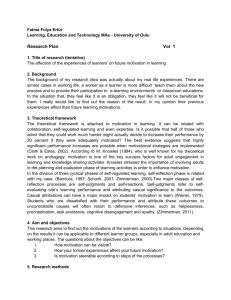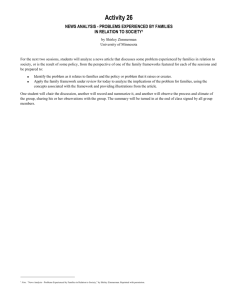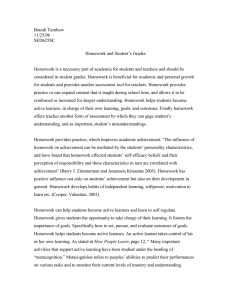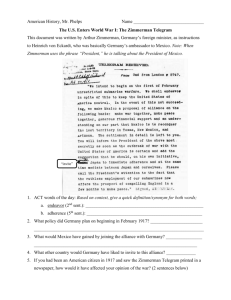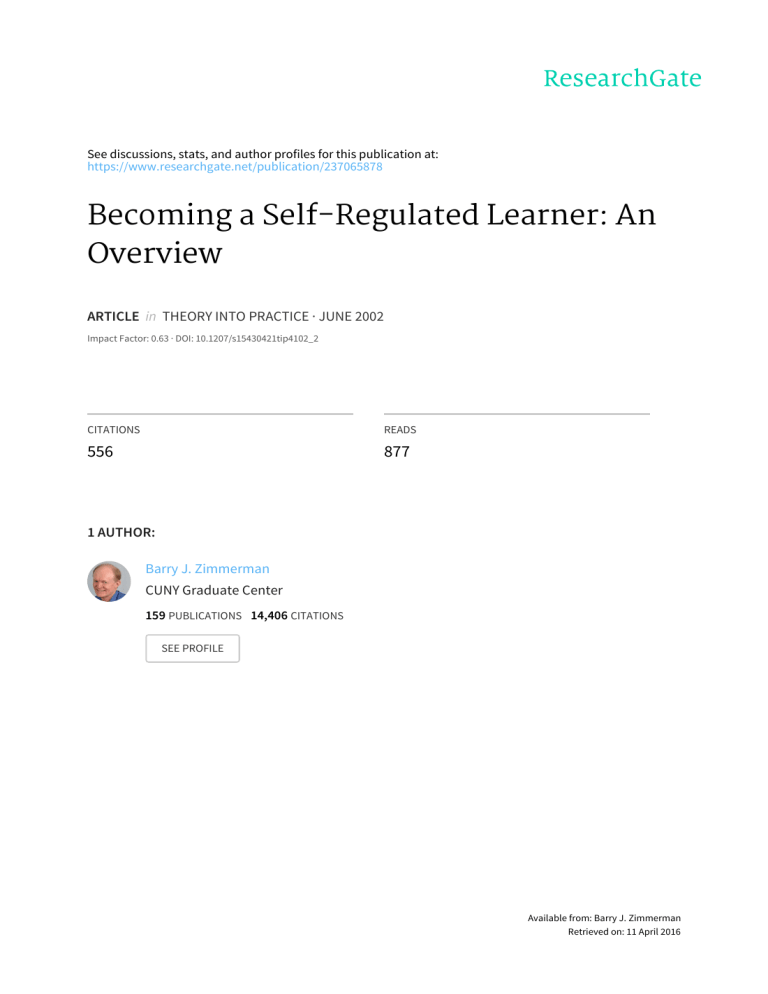
See discussions, stats, and author profiles for this publication at: https://www.researchgate.net/publication/237065878 Becoming a Self-Regulated Learner: An Overview ARTICLE in THEORY INTO PRACTICE · JUNE 2002 Impact Factor: 0.63 · DOI: 10.1207/s15430421tip4102_2 CITATIONS READS 556 877 1 AUTHOR: Barry J. Zimmerman CUNY Graduate Center 159 PUBLICATIONS 14,406 CITATIONS SEE PROFILE Available from: Barry J. Zimmerman Retrieved on: 11 April 2016 Barry . Zimmerman Becoming Learner: a An Self-Regulated Overview N AN ERA OF CONSTANTDISTRACTIONSin the form of portable phones, CD players, computers, and televisions for even young children, it is hardly surprising to discover that many students have not learned to self-regulate their academic studying very well. Consider the case of Tracy, a high school student who is infatuated with MTV. An important mid-term math exam is two weeks away, and she has begun to study while listening to popular music "to relax her." Tracy has not set any study goals for herself-instead she simply tells herself to do as well as she can on the test. She uses no specific learning strategies for condensing and memorizing important material and does not plan out her study time, so she ends up cramming for a few hours before the test. She has only vague self-evaluativestandardsand cannotgauge her academic preparationaccurately.Tracy attributes her learning difficulties to an inherentlack of mathematical ability and is very defensive about her poor study methods. However, she does not ask for help from others because she is afraid of "looking stupid," or seek out supplementarymaterials from the librarybecause she "alreadyhas too much to learn." She finds studying to be anxiety-provoking,has little self-confidence in achieving success, and sees little intrinsic value in acquiring mathematical skill. Barry J. Zimmerman is Distinguished Professor at the Graduate School and University Center of the City University of New York. Self-regulation researchers have sought to understand students like Tracy and to provide help in developing key processes that she lacks, such as goal setting, time management, learning strategies, self-evaluation, self-attributions, seeking help or information,and importantself-motivationalbeliefs, such as self-efficacy and intrinsic task interest. In recent years, there have been exciting discoveries regarding the nature, origins, and development of how students regulate their own learning processes (Zimmerman& Schunk, 2001). Although these studies have clearly revealed how self-regulatory processes lead to success in school, few teachers currently prepare students to learn on their own. In this article, I discuss students' self-regulation as a way to compensate for their individual differences in learning, define the essential qualities of academic self-regulation, describe the structure and function of self-regulatory processes, and, finally, give an overview of methods for guiding students to learn on their own. Changing Conceptions of Individual Differences Since the beginning of public schooling in the United States, educators have wrestled with the presence of substantial differences in individual students' backgrounds and modes of learning. Some students grasped important concepts easily and seemed highly motivated to study, whereas THEORYINTO PRACTICE, Volume 41, Number 2, Spring 2002 Copyright ? 2002 College of Education, The Ohio State University Zimmerman Becoming a Self-Regulated Learner others struggled to understand and retain information and often seemed disinterested. In the 19th century, learning was viewed as a formal discipline, and a student's failure to learn was widely attributed to personal limitations in intelligence or diligence. Students were expected to overcome their individual limitations in order to profit from the curriculum of the school. Conceptions of self-regulatory development at the time were limited to acquiring desirable personal habits, such as proper diction and handwriting. At the dawn of the 20th century, psychology emerged as a science, and the topic of individual differences in educational functioning attracted widespread interest. Diverse reformers, such as John Dewey, E.L. Thorndike, Maria Montessori, and the progressive educators, suggested various ways to alter the curriculum to accommodate students' individual differences, such as grouping of students homogeneously according to age or ability, introducing perceptual-motor learning tasks, and broadeningcourse work to include trainingin practical skills. Laterreformersmatchedinstructionaltreatments to students' aptitude or attitude scores on standardizedtests (Cronbach, 1957). Despite these notable efforts, critics charged that the curriculum of American schools remained too narrow and inflexible to accommodate the psychological needs of all students. Many psychologists and educators discussed the adverse effects of a rigid curriculum on students' self-images (ASCD Yearbook, 1962). During the late 1970s and early 1980s, a new perspective on students' individual differences began to emerge from research on metacognition and social cognition. Metacognition is defined as the awareness of and knowledge about one's own thinking. Students' deficiencies in learning were attributed to a lack of metacognitive awareness of personal limitations and an inability to compensate. Social cognitive researchers were interested in social influences on children's development of self-regulation, and they studied issues such as the effects of teacher modeling and instruction on students' goal setting and self-monitoring (Schunk, 1989; Zimmerman, 1989). Students were asked to set particular types of goals for themselves, such as completing of a certain number of math homework problems, and to self-recordtheir effectiveness in achieving these goals. Students who set specific and proximal goals for themselves displayed superior achievement and perceptions of personal efficacy. Interestingly, simply asking students to self-record some aspect of their learning, such as the completion of assignments, often led to "spontaneous" improvements in functioning (Shapiro, 1984). These effects, termed reactivity in the scientific literature, implied that students' metacognitive (i.e., self) awareness of particular aspects of their functioning could enhance their self-control. Of course, self-awareness is often insufficient when a learner lacks fundamental skills, but it can produce a readiness that is essential for personal change (Zimmerman, 2001). These and related results led researchers to attribute individual differences in learning to students' lack of self-regulation. This perspective focused instead on what students needed to know about themselves in order to manage their limitations during efforts to learn, such as a dyslexic student's knowing to use a particular strategy to read. Although teachers also need to know a student's strengths and limitations in learning, their goal should be to empower their students to become self-aware of these differences. If a student fails to understandsome aspect of a lesson in class, he or she must possess the self-awareness and strategic knowledge to take corrective action. Even if it were possible for teachers to accommodate every student's limitation at any point during the school day, their assistance could undermine the most important aspect of this learning-a student's development of a capability to self-regulate. Defining Self-Regulated Learning in Process Terms Self-regulation is not a mental ability or an academic performance skill; rather it is the selfdirective process by which learners transform their mental abilities into academic skills. Learning is viewed as an activity that students do for themselves in a proactive way rather than as a covert event that happens to them in reaction to teaching. Self-regulation refers to self-generated thoughts, feelings, and behaviors that are oriented to attaining goals (Zimmerman, 2000). These learners are proactive in their efforts to learn because they are 65 / Spring 2002 INTOPRACTICE THEORY Becominga Self-RegulatedLearner aware of their strengths and limitations and because they are guided by personally set goals and task-related strategies, such as using an arithmetic addition strategy to check the accuracy of solutions to subtraction problems. These learners monitor their behavior in terms of their goals and self-reflect on their increasing effectiveness. This enhances their self-satisfaction and motivation to continue to improve their methods of learning. Because of their superior motivation and adaptive learning methods, self-regulated students are not only more likely to succeed academically but to view their futures optimistically. Self-regulation is important because a major function of education is the development of lifelong learning skills. After graduation from high school or college, young adults must learn many important skills informally. For example, in business settings, they are often expected to learn a new position, such as selling a product, by observing proficient others and by practicing on their own. Those who develop high levels of skill position themselves for bonuses, early promotion, or more attractive jobs. In self-employment settings, both young and old must constantly self-refine their skills in order to survive. Their capability to selfregulate is especially challenged when they undertake long-term creative projects, such as works of art, literary texts, or inventions. In recreational settings, learners spend much personally regulated time learning diverse skills for self-entertainment, ranging from hobbies to sports. Although the relationship of self-reliance to success in life has been widely recognized, most students struggle to attain self-discipline in their methods of study today as they did a century ago. What does contemporaryresearch tell us about this desirable but elusive personal quality? First, self-regulation of learning involves more than detailed knowledge of a skill; it involves the self-awareness, self-motivation,and behavioralskill to implementthat knowledge appropriately.For example, there is evidence (Cleary & Zimmerman,2000) that experts differ from non-expertsin theirapplicationof knowledge at crucial times during learning performances, such as correcting specific deficiencies in technique. Second, contemporary research tells us that self-regulation of learning is not a single personal 66 trait that individual students either possess or lack. Instead, it involves the selective use of specific processes that must be personally adapted to each learning task. The component skills include: (a) setting specific proximal goals for oneself, (b) adopting powerful strategies for attaining the goals, (c) monitoring one's performance selectively for signs of progress, (d) restructuring one's physical and social context to make it compatible with one's goals, (e) managing one's time use efficiently, (f) self-evaluating one's methods, (g) attributing causation to results, and (h) adapting future methods. A students' level of learning has been found to vary based on the presence or absence of these key self-regulatory processes (Schunk & Zimmerman, 1994; 1998). Third, contemporaryresearch reveals that the self-motivated quality of self-regulated learners depends on several underlying beliefs, including perceived efficacy and intrinsic interest. Historically, educators have focused on social encouragement and extrinsic "bells and whistles" to try to elevate students' level of motivation. Unfortunately, self-directed studying or practicing was often derided as inherently boring, repetitive, and mind numbing with catchy phrases such as "Drill and kill." However, interviews with experts reveal a very different picture of these experiences (Ericsson & Charness, 1994). Experts spend approximately four hours each day in study and practice and find these activities highly motivating. They vary their methods of study and practice in order to discover new strategies for self-improvement. With such diverse skills as chess, sports, and music, the quantityof an individual's studying and practicing is a strong predictor of his or her level of expertise. There is also evidence that the quality of practicing and studying episodes is highly predictive of a learner's level of skill (Zimmerman & Kitsantas, 1997; 1999). However, few beginners in a new discipline immediately derive powerful self-motivational benefits, and they may easily lose interest if they are not socially encouraged and guided, as most music teachers will readily attest (McPherson & Zimmerman, in press). Fortunately,the motivation of novices can be greatly enhanced when and if they use high-quality self-regulatoryprocesses, such as close self-monitoring. Students who have the capabilities Zimmerman Becoming a Self-Regulated Learner Structure and Function of Self-Regulatory Processes learning psychologists view the structure of selfregulatory processes in terms of three cyclical phases. The forethought phase refers to processes and beliefs that occur before efforts to learn; the performance phase refers to processes that occur during behavioral implementation, and self-reflection refers to processes that occur after each learning effort. The processes that have been studied in each phase to date are shown in Figure 1, and the function of each process will be described next (Zimmerman, 2000). This brings us to the essential question of how does a student's use of specific learning processes, level of self-awareness, and motivational beliefs combine to produce self-regulated learners? Social Forethought phase There are two major classes of forethought phase processes: task analysis and self-motivation. to detect subtle progress in learning will increase their levels of self-satisfaction and their beliefs in their personal efficacy to perform at a high level of skill (Schunk, 1983). Clearly, their motivation does not stem from the task itself, but rather from their use of self-regulatory processes, such as selfmonitoring, and the effects of these processes on their self-beliefs. iii Performance Phase Self-Co, ntrol Image:ry Self-instruction Attention f ocusing Task strategies Self-Obse rvation Self-reco>rding Self-experinnentation ?l 1 ssnassscsss .. -v l .! Forethought Phase TaskAnalysis I 1 Self-Reflection Phase I 0I Self-Judgment Goal setting Self-evaluation Causal attribution Strategicplanning Self-Reaction Self-Reaction Self-Motivation Beliefs Self-efficacy Outcome expectations Intrinsicinterest/value Learninggoal orientation . efficacy Sel.l f-I~ I Self-satisfaction/affect Adaptivedefensive Figure 1. Phases and Subprocesses of Self-Regulation. From B.J. Zimmerman and M. Campillo (in press), "Motivating Self-Regulated Problem Solvers." In J.E. Davidson and Robert Sternberg (Eds.), The Nature of Problem Solving. New York: Cambridge University Press. Adapted with permission. 67 THEORYINTO PRACTICE/ Spring 2002 Becominga Self-RegulatedLearner Task analysis involves goal setting and strategic planning. There is considerable evidence of increased academic success by learners who set specific proximal goals for themselves, such as memorizing a word list for a spelling test, and by learners who plan to use spelling strategies, such as segmenting words into syllables. Self-motivation stems from students' beliefs about learning, such as self-efficacy beliefs about having the personal capability to learn and outcome expectations about personal consequences of learning (Bandura, 1997). For example, students who feel self-efficacious about learning to divide fractions and expect to use this knowledge to pass a college entranceexam are more motivated to learn in a self-regulated fashion. Intrinsic interest refers to the students' valuing of the task skill for its own merits, and learning goal orientation refers to valuing the process of learning for its own merits. Students who find the subject matter of history, for example, interesting and enjoy increasing their mastery of it are more motivated to learn in a selfregulated fashion. Performance phase Performance phase processes fall into two major classes: self-control and self-observation. Self-control refers to the deployment of specific methods or strategies that were selected during the forethought phase. Among the key types of selfcontrol methods that have been studied to date are the use of imagery, self-instruction, attentionfocusing, and task strategies. For example, in learningthe Spanish word pan for "bread,"an English-speaking girl could form an image of a bread pan or selfinstructusing the phrase "breadpan." She could also locate her place of study away from distractingnoises so she could control her attention better. For a task-strategy,she could group the Spanish word pan with associated words for foods. Self-observation refers to self-recording personal events or self-experimentation to find out the cause of these events. For example, students are often asked to self-record their time use to make them aware of how much time they spend studying. A boy may notice that when he studied alone, he finished his homework more quickly than when studying with a friend. To test this hypothesis, 68 the boy could conduct a self-experiment in which he studied parallel lessons alone and in the presence of his friend to see whether his friend was an asset or a liability. Self-monitoring,a covert form of self-observation,refers to one's cognitive trackingof personal functioning, such as the frequency of failing to capitalize words when writing an essay. Self-reflection phase There are two major classes of self-reflection phase processes: self-judgment and self-reaction. One form of self-judgment, self-evaluation, refers to comparisons of self-observed performances against some standard, such as one's prior performance, another person's performance, or an absolute standard of performance. Another form of self-judgment involves causal attribution, which refers to beliefs about the cause of one's errors or successes, such as a score on a mathematics test. Attributing a poor score to limitations in fixed ability can be very damaging motivationally because it implies that efforts to improve on a future test will not be effective. In contrast, attributinga poor math score to controllable processes, such as the use of the wrong solution strategy, will sustain motivation because it implies that a different strategy may lead to success. One form of self-reaction involves feelings of self-satisfaction and positive affect regarding one's performance. Increases in self-satisfaction enhance motivation, whereas decreases in self-satisfaction underminefurtherefforts to learn (Schunk, 2001). Self-reactions also take the form of adaptive/defensive responses. Defensive reactions refer to efforts to protect one's self-image by withdrawing or avoiding opportunities to learn and perform, such as dropping a course or being absent for a test. In contrast, adaptive reactions refer to adjustments designed to increase the effectiveness of one's method of learning, such as discarding or modifying an ineffective learning strategy. This view of self-regulation is cyclical in that self-reflections from prior efforts to learn affect subsequent forethoughtprocesses (e.g., self-dissatisfaction will lead to lower levels of self-efficacy and diminished effort during subsequentlearning) (Zimmerman & Bandura, 1994). In supportof this cyclical view of self-regulation, high correlations were Zimmerman Becoming a Self-Regulated Learner found among learners' use of forethought, performance, and self-reflection phase processes (Zimmerman & Kitsantas, 1999). For example, students who set specific proximal goals are more likely to selfobserve their performancein theses areas, more likely to achieve in the targetarea,and will display higher levels of self-efficacy than students who do not set goals (Bandura& Schunk, 1981). Otherstudies have revealed that experts display significantly higher levels of self-regulatory processes during practice efforts than novices (Cleary & Zimmerman,2000). The self-regulation profile of novices is very distinctive from that of experts. Novices fail to engage in high-quality forethoughtand instead attempt to self-regulatetheir learningreactively. That is, they fail to set specific goals or to self-monitor systematically, and as a result, they tend to rely on comparisons with the performance of others to judge their learning effectiveness. Because typically other learners are also progressing,their performancerepresents a constantly increasing criterion of success that is very difficult to surpass. Furthermore,learners who make comparative self-evaluations are prompted to attributecausation to ability deficiencies (which are also normativein nature),and this will produce lower personal satisfaction and prompt defensive reactions. In contrast, the self-regulation profile of experts reveals they display high levels of selfmotivation and set hierarchicalgoals for themselves with process goals leading to outcome goals in succession, such as dividing a formal essay into an introduction,a body, and a conclusion. Experts plan learning efforts using powerful strategies and selfobserve their effects, such as a visual organizer for filling in key information (Zimmerman & Risemberg, 1997). They self-evaluate their performance against their personal goals ratherthan other learners' performance, and they make strategy (or method) attributions instead of ability attributions. This leads to greater personal satisfactionwith theirlearning progress and furtherefforts to improve their performance. Together these self-reactions enhance various self-motivational beliefs of experts, such as self-efficacy, outcome expectations, learning goal orientation, and intrinsic interest. Knowing the differences in the structureand function of self-regulatoryprocesses between experts and novices has enabled researchers to formulate intervention programs in schools for children who display lower levels of self-regulatory development (Schunk & Zimmerman, 1998). Teaching Students to Become Self-Regulated Learners Research on the quality and quantity of students' use of self-regulatory processes has revealed high correlations with academic achievement track placement as well as with performance on standardized test scores (Zimmerman& Martinez-Pons, 1986). There is also evidence that students' use of self-regulatory processes is distinctive from but correlated with general measures of ability, such as verbal ability (Zimmerman & Bandura, 1994). Although many self-regulatory processes, such as goal setting and self-monitoring, are generally covert, teachers are aware of many overt manifestations of these processes, such as students' self-awareness of the quality of their work and preparedness in class (Zimmerman & Martinez-Pons, 1988). Recent research shows that self-regulatory processes are teachable and can lead to increases in students' motivation and achievement (Schunk & Zimmerman, 1998). Although research findings strongly support the importance of students' use of self-regulatory processes, few teachers effectively prepare students to learn on their own (Zimmerman, Bonner, & Kovach, 1996). Students are seldom given choices regarding academic tasks to pursue, methods for carrying out complex assignments, or study partners. Few teachers encourage students to establish specific goals for their academic work or teach explicit study strategies. Also, students are rarely asked to self-evaluate their work or estimate their competence on new tasks. Teachers seldom assess students' beliefs about learning, such as self-efficacy perceptions or causal attributions, in order to identify cognitive or motivational difficulties before they become problematic. Contraryto a commonly held belief, self-regulated learning is not asocial in nature and origin. Each self-regulatory process or belief, such as goal setting, strategy use, and self-evaluation, can be learned from instruction and modeling by parents, teachers, coaches, and peers. In fact, self-regulated students seek out help from others to improve 69 THEORYINTO PRACTICE/ Spring 2002 Becoming a Self-Regulated Learner their learning. What defines them as "self-regulated" is not their reliance on socially isolated methods of learning, but rather their personal initiative, perseverance, and adoptive skill. Self-regulated students focus on how they activate, alter, and sustain specific learning practices in social as well as solitary contexts. In an era when these essential qualities for lifelong learning are distressingly absent in many students, teaching self-regulated learning processes is especially relevant. Note 1. Correspondence concerning this article should be directed to Barry J. Zimmerman, Ph.D. Program in Educational Psychology, Graduate School and University Center of the City University of New York, 365 Fifth Ave., New York, NY 10016-4309 or bzimmerman @gc.cuny.edu. References ASCD Yearbook. (1962). Perceiving behaving becoming. Washington DC: Association for Supervision and Curriculum Development. Bandura, A. (1997). Self-efficacy: The exercise of control. New York: W.H. Freeman. Bandura, A., & Schunk, D.H. (1981). Cultivating competence, self-efficacy, and intrinsic interest through proximal self-motivation. Journal of Personality and Social Psychology, 41, 586-598. Cleary, T., & Zimmerman, B.J. (2000). Self-regulation differences during athletic practice by experts, nonexperts, and novices. Journal of Applied Sport Psychology, 13, 61-82. Cronbach, L.J. (1957). The two disciplines of scientific psychology. American Psychologist, 12, 671-684. Ericsson, A.K., & Charness, N. (1994). Expert performance: Its structure and acquisition. American Psychologist, 49, 725-747. McPherson, G.E., & Zimmerman, B.J. (in press). Selfregulation of musical learning: A social cognitive perspective. In R. Colwell (Ed.), Second handbook on music teaching and learning. New York: Oxford University Press. Schunk, D.H. (1983). Progress self-monitoring: Effects on children's self-efficacy and achievement. Journal of Experimental Education, 51, 89-93. Schunk, D.H. (1989). Social cognitive theory and selfregulated learning. In B.J. Zimmerman & D.H Schunk (Eds.), Self-regulated learning and academic achievement: Theory, research, and practice (pp. 83-110). New York: Springer Verlag. Schunk, D.H. (2001). Social cognitive theory and selfregulated learning. In B.J. Zimmerman & D.H Schunk (Eds.), Self-regulated learning and academic achievement: Theoretical perspectives (2nd ed., pp. 125-152). Mahwah, NJ: Erlbaum. 70 Schunk, D.H., & Zimmerman, B.J. (Eds.). (1994). Selfregulation of learning and performance: Issues and educational applications. Hillsdale, NJ: Erlbaum. Schunk, D.H., & Zimmerman, B.J. (Eds.). (1998). Selfregulated learning: From teaching to self-reflective practice. New York: Guilford Press. Shapiro, E.S. (1984). Self-monitoring procedures. In T.H. Ollendick & M. Hersen (Eds.), Child behavior assessment: Principles and procedures (pp. 148-165). New York: Pergamon. Zimmerman, B.J. (1989). A social cognitive view of self-regulated academic learning. Journal of Educational Psychology, 81, 329-339. Zimmerman, B.J. (2000). Attainment of self-regulation: A social cognitive perspective. In M. Boekaerts, P.R. Pintrich, & M. Zeidner (Eds.), Handbook of self-regulation (pp. 13-39). San Diego, CA: Academic Press. Zimmerman, B.J. (2001). Theories of self-regulated learning and academic achievement: An overview and analysis. In B.J. Zimmerman & D.H. Schunk (Eds.), Self-regulated learning and academic achievement: Theoretical perspectives (2nd ed., pp. 1-37). Mahwah, NJ: Erlbaum. Zimmerman,B.J., & Bandura,A. (1994). Impact of selfregulatory influences on writing course attainment. AmericanEducationalResearchJournal, 31, 845-862. Zimmerman, B.J., Bonner, S., & Kovach, R. (1996). learners: Beyond Developing self-regulated achievement to self-efficacy. Washington, DC: American Psychological Association. Zimmerman, B.J., & Campillo, M. (in press). Motivating self-regulated problem solvers. In J.E. Davidson & R. Sternberg (Eds.), The nature of problem solving. New York: Cambridge University Press. Zimmerman, B.J., & Kitsantas, A. (1997). Developmental phases in self-regulation: Shifting from process to outcome goals. Journal of Educational Psychology, 89, 29-36. Zimmerman, B.J., & Kitsantas, A. (1999). Acquiring writing revision skill: Shifting from process to outcome self-regulatory goals. Journal of Educational Psychology, 91, 1-10. Zimmerman,B.J., & Martinez-Pons,M. (1986). Development of a structuredinterview for assessing students' use of self-regulatedlearningstrategies.AmericanEducational Research Journal, 23, 614-628. Zimmerman, B.J., & Martinez-Pons, M. (1988). Construct validation of a strategy model of student self-regulated learning. Journal of Educational Psychology, 80, 284-290. Zimmerman, B.J., & Risemberg, R. (1997). Becoming a self-regulated writer: A social cognitive perspective. ContemporaryEducational Psychology, 22, 73-101. Zimmerman, B.J., & Schunk, D.H. (Eds.). (2001). Selfregulated learning and academic achievement: Theoretical perspectives (2nd ed.). Mahwah, NJ: Erlbaum.
